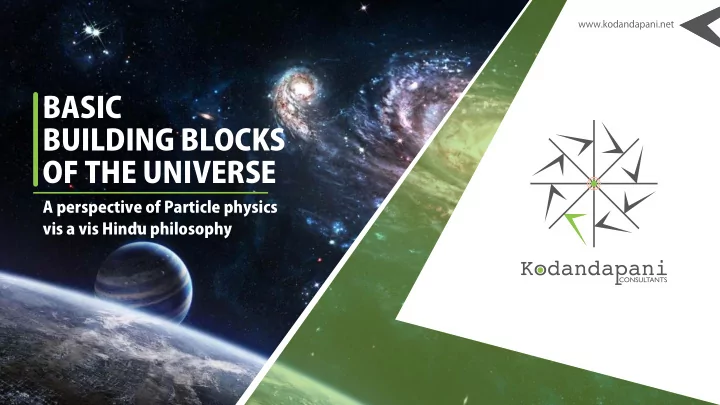

www.kodandapani.net BASIC� BUILDING�BLOCKS� OF�THE�UNIVERSE A�perspective�of�Particle�physics� vis�a�vis�Hindu�philosophy
www.kodandapani.net Higgs�bosons/�Higgs�Field� 25.� 21 the�Higgs�boson�or�a�similar�particle?� � What�would�the�world�look�like�without� 24.� 20 More�questions�with�Higgs�Boson� 23.� 20 22.� 21 19 Why�is�there�mass?� 21.� 19 The�undiscovered� 20.� 18 Discovery�of�top�quark�and�further�questions� 19.� 18 Uni�cation�Theories� 26.� 18.� 28 PART�-�A� Page�No.� S.No.� �(Particle�Physics) PART�-�A� Page�No.� S.No.� 28 New�windows�to�the�particle�world-�Neutrinos� 31.� Omni-potent�Observer� Speculations�on�other�types�of�building�blocks� 30.� 27 de�Broglie-Bohm�theory� 29.� 26 Reality� 28.� 24�&�25 Consciousness�&�QM� 27.� 22�&�23 Searching�for�top�quark� 17 02 06 8.� 08 Discovery�of�New�Quark:�The�Upsilon� 7.� 07 Quark�Model� 6.� 07� Cosmic�Rays� 5.� A�Strange�New�Particle�-�The�Lambda� 08 4.� 06 Cosmic�Rays� 3.� 05 Quarks,�Leptons,�and�Bosons�� 2.� 04 The�Building�Blocks�of�a�Dew�Drop� 1.� INDEX Building�Blocks�in�1977� 9.� Interactions�out�of�thermal�equilibrium� 12 17.� 15�&�16 CP-symmetry�violation� 16.� 14 Baryon�number�violation� 15.� 13 Sakharov�conditions� 14.� Baryonic�Asymmetry� Discovery�of�a�New�Quark:�b�Quark� 13.� 11 What's�Special�about�Antimatter� 12.� 10 Antimatter� 11.� 10 Bottom�to�Top� 10.� 09 �(Particle�Physics)
www.kodandapani.net Modern�Physics�and�Hindu�Philosophy� 4.� 44 Wavefunction/�Superposition/�Entanglement� 3.� 43 Brahma�Satyam,�Jagat�Mithya� 2.� 42 1.� 45 INDEX �(Philosophical�Content) PART�-�B� Page�No.� S.No.� �(Particle�Physics) PART�-�A� Page�No.� Crux�of�Hindu�Philosophy� 5.� 41 49 Properties�of�Omkara�� 11.� 50 The�Connection� 10.� 49 Building�blocks�as�per�The�Hindu�philosophy� 9.� Further�questions� Birth�of�the�Universe/�Vayu�puranam� 8.� 48 Neutrino�Oscillations� 7.� 47 Theory�of�Relativity�&�Gita� 6.� 46 S.No.� Type�IIB�string�theory� 03 Constraints� 37.� 32 Fundamentals� 36.� 32 Best�Candidate� 35.� 31 34.� 33 30 String�Theory� 33.� 29 between�two�identities.� � Neutrinos�from�the�atmosphere�shift� 32.� Dimensions� 38.� 45.� 42.� 40 �Type�IIA�string�theory� 44.� 39 Type�II�string�theory� 43.� �38 Type�IIA� 37 Dualities�and�M-theory� Uni�cation�of�Superstring�theories� 41.� 36 T-Duality� 40.� 35 S-Duality� 39.� 34 50,�51�&�52
www.kodandapani.net 04 The�Building�Blocks�of�a�Dew�Drop A�dew�drop�is�made�up�of�many�molecules�of�water�(1021�or�a�billion�trillion).�Each� molecule�is�made�of�an�oxygen�atom�and�two�hydrogen�atoms�(H2O).�At�the�start�of�the� 20th�century,�atoms�were�the�smallest�known�building�blocks�of�matter. Each�atom�consists�of�a�nucleus�surrounded�by�electrons.�Electrons�are�leptons�that�are� bound�to�the�nucleus�by�photons,�which�are�bosons.�The�nucleus�of�a�hydrogen�atom�is� just�a�single�proton.�Protons�consist�of�three�quarks.�In�the�proton,�gluons�hold�the� quarks�together�just�as�photons�hold�the�electron�to�the�nucleus�in�the�atom
www.kodandapani.net 05 Quarks,�Leptons,�and�Bosons Physicists�currently�believe�there�are�three�types�of�basic�building�blocks�of�matter:�quarks,�leptons,� and�bosons.�Quarks�and�leptons�make�up�everyday�matter,�which�is�held�together�by�bosons.�Each� boson�is�associated�with�a�force.�The�photon,�the�unit�of�the�electromagnetic�force,�holds�the� electron�to�the�nucleus�in�the�atom.�The�way�these�particles�combine�dictates�the�structure�of� matter. Elementary� particles� are� particles� with� no� measurable� internal� structure;� that� is,� it� is� unknown� whether�they�are�composed�of�other�particles.�They�are�the�fundamental�objects�of�quantum��eld� theory.� Many� families� and� sub-families� of� elementary� particles� exist.� Elementary� particles� are� classi�ed�according�to�their�spin.�Fermions�have�half-integer�spin�while�bosons�have�integer�spin.�All� the�particles�of�the�Standard�Model�have�been�experimentally�observed,�recently�including�the� Higgs�boson�in�2012.�Many�other�hypothetical�elementary�particles,�such�as�the�graviton,�have�been� proposed,�but�not�observed�experimentally.
www.kodandapani.net 06 Cosmic�Rays Early�particle�physicists�studied�cosmic�rays,�a�naturally�occurring�stream�of�high�energy�particles� from�outer�space.�Cosmic�rays�were�the��rst�source�of�unstable,�short-lived�particles.�Later,�physicists� discovered�that�most�of�the�building�blocks�of�matter�live�for�so�short�a�time�that�we�do�not�see�them� in�everyday�matter.�One�of�the�unstable�particles�they�found�was�the�muon�(µ),�a�lepton. One�particle�discovered�in�cosmic�rays�was�the�lambda,�identi�ed�by�particle�tracks�forming�the� Greek�symbol�Lambda�in�the�cloud�chamber.�The�lambda�has�no�electric�charge�so�it�leaves�no�trace� until�it�decays�into�one�positively�and�one�negatively�charged�particle.�They�leave�a�Lambda�pattern� (upside�down�V),�as�seen�on�the�right.�Lambdas�were�the��rst�of�a�group�of�particles�called�"Strange"� because�they�decayed�more�slowly�than�expected. A�Strange�New�Particle�-�The�Lambda
www.kodandapani.net 07 Cosmic�Rays New�technology�in�the�early�1960s�allowed�physicists�to�build�accelerators�to�create�many�new� particles�by�shooting�energetic�particles�at�targets.�These�particles�were�short-lived�and�decayed� quickly�into�o�spring�particles.�With�even�higher�energy�accelerators,�physicists�found�an�exotic� array�of�new�particles.�They�developed�theories�to�explain�how�all�the�particles�in�this�"Particle�Zoo"� could�be�made�from�a�few�basic�building�blocks. In�1964,�physicists�proposed�quarks�as�the�building�blocks�of�many�of�the�particles�in�the�"Particle� Zoo."�In�this�theory�all�everyday�objects,�such�as�our�bodies�and�the�homes�we�live�in,�could�be�made� from�three�basic�particles:�up�and�down�quarks�and�electrons.�At�that�time�the�Quark�Model�was�one� of�many�possible�explanations�and�was�not�accepted�for�over�a�decade. Quark�Model
www.kodandapani.net 08 Discovery�of�New�Quark:�The�Upsilon New�accelerators�with�higher�energies�smashed�beams�of�particles�into��xed�targets�to�produce� short-lived� particles� with� high� masses.� One� of� these� particles,� the� upsilon,� had� properties� that� implied�that�it�could�not�be�made�of�the�known�four�quarks:�up,�down,�strange�and�charm.�Physicists� concluded�that�the�upsilon�was�made�of�a�new�quark,�the�bottom�quark,�and�its�antiquark.� By�early�1977,�two�complete�generations�of�particles�had�been�discovered.�With�the�discovery�of�the� upsilon�that�summer,�physicists�saw�the�possibility�of�a�third�generation�of�particles. Building�Blocks�in�1977
www.kodandapani.net 09 Discovery�of�a�New�Quark:�b�Quark New�accelerators�with�higher�energies�smashed�beams�of�particles�into��xed�targets�to�produce� short-lived� particles� with� high� masses.� One� of� these� particles,� the� upsilon,� had� properties� that� implied�that�it�could�not�be�made�of�the�known�four�quarks:�up,�down,�strange�and�charm.�Physicists� concluded�that�the�upsilon�was�made�of�a�new�quark,�the�bottom�quark,�and�its�antiquark.�Leon� Lederman,� the� second� director� of� Fermilab,� headed� this� 1977� experiment.� Today� there� are� accelerators�dedicated�to�the�production�of�upsilons�and�studies�of�the�bottom�quark.
Recommend
More recommend